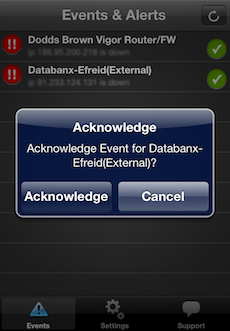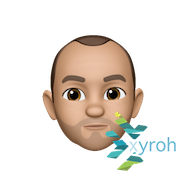The iPhone App for Zenoss – That’d be KyK
The iPhone App for Zenoss – That’d be KyK then
Andy Flisher is a Software Developer based in the North East of England specialising in cross platform development. Mobile Development experience includes Windows Phone, Android, and iPhone Apps. Desktop Software Development includes bespoke Windows, Linux, and Mac Applications. Web Development Skills include PHP, Perl, Python, ASP (Classic and .NET) – Andy Flisher on Google+

Zenoss is a monitoring system, we use it the office, and basically it sits on one of our servers out in the Cloud (the Internet to most people) and regularly monitors our kit, servers, and our clients kit too, to make sure they’re still up and doing what they should. If something disappears, a disk gets full, or a server overloaded it alerts our Engineering team and we swoop into action. When there’s an alert it keeps on alerting until you respond and acknowledge it – that’s where KyK comes in.
KyK?– It’s from the Afrikaans for ‘Watching’ – which is the easiest way to explain what Zenoss does.
Yes, yes, very clever – but what is it? Well, it’s an iPhone App, an iPhone client for Zenoss if you will, although not just iPhone, it will work on any handheld iOS device, so that’s the iPod Touch and the iPad – Oh, and I wrote it, I’m an App Developer too you know, so that’s Web Based Software, Desktop Software, and Mobile Software – clever me 🙂
Back to the top, when there’s an alert in Zenoss you have to get on line, login, see the agent and acknowledge it. Alerts don’t happen at convenient times, so KyK is aimed at making it easier. Fire up the App, it automatically polls your Zenoss server and lists any events. New events are highlighted at the top, tap, confirm, acknowledged – that simple, convenient, mobile. You can also view more detail and alert history for events too if you want.
What’s next? Well KyK (and KyK Lite – a free version that lets you see events but not acknowledge them) is out there now in the Apple iOS App Store, there’s a version for Android in Beta (that basically means half done and in testing) and it may expand beyond that, I have half an idea for an enhanced iPad / Tablet version with a lot more management features, but we’ll have to canvas demand to justify developing that.
How’s KyK doing, setting the Zenoss Community on fire? Not yet, but it’s only been out for a few weeks, we have customers in Mexico, Canada, the US, South Africa, and of course the UK – it’s interesting being global – but also a challenge. I deliberately wrote a support / feedback mechanism into the app so users can contact us as easily as possible, it’ll also send me useful debug logs so I can understand what has and hasn’t happened, so that makes life easier, but of course we have timezones and languages to deal with, thankfully most people internationally speak better English than we do. Today I’ve released version 1.1 which fixes a couple of minor bugs and user interface anomalies, and massively adds support for Zenoss 4 and above (Annoyingly Zenoss 4 came out of Beta whilst KyK was in the worlds longest App Review, so we had no opportunity to test and ensure compatibility before release), and have a few features to add for the next release. The big milestone will be 1.2 when it’ll go live for Android too, just need a Tardis and a few round-too-it’s and we’ll be there.
Bigger plans, commercially, we’d like to talk to Zenoss themselves, or their clients, KyK is written in such a way that it could easily be re-branded, or custom re-written as an Enterprise App to be deployed large scale – but that sounds a lot like Marketing, which is for another day and the right frame of mind, step 1 (and 1.1) complete.
In the meantime if you use Zenoss, or know someone that does, and have an iPhone in your hands, buy KyK for Zenoss on the iPhone, leave a nice review (if you can), and make me smile, thus justifying a lot of long hours and thought!
Andy works for dotUK (www.dotuk.net) a North Based Web and Software Development firm he helped found.
Stockton Riverside Festival
Some street photography shots from the 2012 Stockton Riverside Festival (SIRF) ….
See the full collection over at the Flickr Gallery
The New Basecamp Upgrade – Do We / Don’t We?
We use Basecamp, sorry Basecamp Classic, in the office for the majority of our project management needs, moreso I live within Omnifocus on the Mac and iPhone so make use of Spootnik to sync between Omnifocus and Basecamp which as I understand doesn’t currently work, so changes are a big deal, but these are bigger than most. The ‘upgrade path’ is more than that, it’s in effect testing and choosing a new product, except we don’t want a new product, if I’m evaluating a new product then I’ll probably be looking outside of Basecamp full stop.
On top of that, if we do evaluate there’s no turning back, so we have to work in parallel. I’ve not been motivated to even sign up for a free trial, complete apathy. So I googled, let the internet do my thinking for me, and found this, which pretty much sums up how risky a decision 37 signals (the makers of Basecamp) have made. Full credit’s made and follow the link to the full article, felt wrong to quote much more.
My conclusion, I’ll not even bother looking to see what New Basecamp is like, not now, not as an upgrade. I might however have a look to see if there’s a better suited product than Basecamp Classic, but it might not be from 37 Signals, or we may well stay where we are, quite happy.
The New Basecamp, New Coke, and New Decisions
There is so much to say about The New Basecamp that reviewing this release is going to take several posts. So, for starters let’s talk about the big picture decisions related to this major new release.
The Name
This week we got “The New” Basecamp and The New iPad. It seems to be an odd choice for both Basecamp and the iPad.
;
In theory, this works better for hardware. The 37Signals guys were quick to point out that Honda rolls out a new Civic every year and they don’t name them the Civic HD, Civic 4S, etc. You just get a new Civic. But the car industry has the decency to put a model year on it.
;
Apple’s been playing this game for a while. I own a white MacBook and 95% of the time the actual name of the model doesn’t matter. But when it does matter, I have to know that it is the 13-in Early 2009 MacBook. I suspect “the new iPad” will have the same issue. This is because this image to the left won’t help you much in 2014 when you are trying to get support and they need to know if you have an iPad 2, a 2012 iPad, or a 2013 iPad or whatever.
;
But with Basecamp, the name game feels even more strange. What we once knew as Basecamp is now Basecamp Classic. And this new thing, with a completely different feature set has assumed the Basecamp name and is generally prefaced with “the new” to differentiate it.
;
Why the name games? Did Ryan in The Office completely ruin the ability of software companies to name their product “two-dot-oh”?
;
The most straightforward answer seems to be this:
;
Unlike Fog Creek with Trello and FogBugz, 37Signals wanted to leverage the brand value of their existing product with their new, created-from-scratch product. Where Fog Creek has created a second project management tool to live along side their existing tool, 37Signals is maintaining the brand name with the new product. Think: New Coke. Oh wait, maybe that’s not the image they desired.
;
However, unlike most upgrades (excluding Apple’s treatment of video editing software) this “upgrade” actually removes several previously “key” features.
;
A major release like this is going to upset many users however you do it. If you position it as Basecamp 2.0 and you remove key features, well, users are going to freak out.
;
So, the team at 37Signals appears to be trying to walk a fine line. The new thing is new and different, but not the same product at all. So, you get the old thing renamed and a few Jedi mind tricks later… everybody is going to be okay. In theory. But this feels like a decision they will regret if for no other reason than they are going to get tired of talking about it.
;
No Auto Upgrade
Another complication is the decision to not auto-upgrade users to the new Basecamp. Instead, your current projects and accounts may continue to live on forever (or some version of forever) in Basecamp Classic. You may give the new Basecamp a whirl via a free trial and import your projects over, but you don’t have to do so.
;
Why would anybody stay in the old version of a product if the new version is available for essentially the same price? (Let’s ignore the issue about no longer supporting a “free” version in the new Basecamp.)
;
This isn’t a decision that was made by accident. There is a really good reason, but it’s going to frustrate a lot of folks. You see, the new Basecamp really is a brand new product. Completely new code, new features, new style, and all the things that go with a new product. Being a new product, the new Basecamp has a limited feature set.
;
Yes, there are new features that Basecamp (classic) never had. But there are features that are missing. Some are quite intentional (no private messages!) and some are more complex (no time tracking!).
;
Tangent: When Salesforce rolls out a new release (three times a year) you rarely lose key features. And if something is going to change, there is significant build up to the event that includes transition guides, the works. If this winter, Salesforce rolled out a release that say, removed the Opportunities object then all hell would break lose. You don’t just auto-upgrade users to a version of your application that does not include key functionality they have previously enjoyed.
;
And thus, 37Signals put themselves in an awkward situation. Or, more importantly, they put their users in an awkward situation. You can keep on paying the same price for eternity for the old tool that they are not likely to enhance ever again, or you can move to the new application with a different feature set.
;
Good luck on convincing your budget guy of option one and good luck of convincing your users of option two.
;
continue reading via The New Basecamp, New Coke, and New Decisions « Technical Support Is At The Deli.
Andy Flisher is a Software Developer based in the North East of England specialising in cross platform development. Mobile Development experience includes Windows Phone, Android, and iPhone Apps. Desktop Software Development includes bespoke Windows, Linux, and Mac Applications. Web Development Skills include PHP, Perl, Python, ASP (Classic and .NET) – Andy Flisher on Google+
Rachel’s Parachute Jump for Butterwick Hospice
At the third time of asking, weather not nerves!, Rach managed her 10,000ft Tandem skydive at Peterlee Skydive Academy (huge thanks to them by the way, they were great), all in aid of Butterwick Hospice. If you wish to sponsor her you can whilst the page is still open at – http://www.justgiving.com…
London 2012 – Torch Relay Stockton on Tees

The London 2012 Torch Relay in Stockton on Tees, the relay hit the North East, and Stockton on Tees on 17th June 2012, here’s our view down Greens Lane, near Ian Ramsey School
BTServer causing high CPU utilization (When wake from Sleep)
Symptoms are that your Mac wakes from sleep and CPU usage spikes to 100%, Activity Monitor show’s it the BTServer process using it all and you have to quit it. This happens, 100% reproducible, when you’ve used the iOS Simulator at some point since the last reboot.
This isn’t a perfect solution, in fact it’s ruddy useless of the iPhone / iPad app you’re developing uses Bluetooth, but if it doesn’t then you can get away without BTServer, so we disable it.
Thanks to ‘Frankie’ via the Apple Support Forums
Re: BTServer causing high CPU utilization
Mar 4, 2012 5:51 AM (in response to Ryan Homer)
I have the same issue. My mac is 10.6.8 and I’m using XCode 4.2.
Just try:
Go to the Macintosh HD > Developer > Platforms > iPhoneSimulator.platform > Developer > SDKs > iPhoneSimulator5.0.sdk > System > Library > LaunchDaemons directory and then open the plist file from there. Locate the “Disabled” key and change its value from “NO” to “YES”.
You need to change permission in the file and also its parent folder in order to save the new permission of plist file before modifying in XCode.
Hope this help.
Frankie
via BTServer causing high CPU utilization: Apple Support Communities.
Andy Flisher is a Software Developer based in the North East of England specialising in cross platform development. Mobile Development experience includes Windows Phone, Android, and iPhone Apps. Desktop Software Development includes bespoke Windows, Linux, and Mac Applications. Web Development Skills include PHP, Perl, Python, ASP (Classic and .NET) – Andy Flisher on Google+
Instant Messaging on Multiple Devices
Instant Messaging on Multiple Devices – struggling to believe this problem hasn’t been solved properly yet
Redesign Instant Messaging Platforms to be Used on Multiple Devices
POSTED AT JANUARY 29, 2011 // TECHNOLOGY
Most of the people who care about it have a smartphone and a data plan. They get their emails on the phone, browse the web and often also use instant messaging.
Software like Google Talk, Yahoo!Messenger, or Skype now exists for almost all devices and operating system: Windows, OS X, iPads, iPhones, Blackberry, Android, …
But what happens when you use it on multiple devices at the same time? Maybe you are on your PC, then get pulled in a meeting and bring your ipad, and then go out for a coffee and have your cellphone with you. Sounds familiar?
Today, either the platform sends the messages to all the devices or just to the last one from which you logged in. Annoying in both cases. It’s time to change.
The IM software should be written so that it knows what you are using. For example, as long as you type or use the mouse one can assume you are using the PC. If you start touching the ipad and not the PC, then switch to that. If the phone detect movements (GPS?) and there is no activity on the other devices, switch to that.
In addition, the chat logs should be kept on the sever, so that whatever device you use you always have them with you.
Privacy problems you say? Not really. You just need to encrypt the messages that you send and receive and use the same key on your devices, so that they can encode/decode them locally and on the server there is just and indecipherable series of characters. The Off-The-Record plugin, available for Audium and Pidgin, does just that.
It is not that hard. Who will get there first? A new startup or the IM companies?
via Redesign Instant Messaging Platforms to be Used on Multiple Devices.
Convert a Version 7 vmdk Disk to Version 4
This post is to highlight how you can convert a Version 7 vmdk disk to version 4. Basically the background is that since Vsphere 4.0 the default Virtual Machine Hardware Version is version 7, under Esx or Esxi 3.5 it was virual machine version 5 (I think versions 5 and 6 are under VMWare workstation), so if you have any need to take a virtual machine from 4.0 / 4.1 / 5.0 etc backwards to a 3.5 host you’re (by default), knackered.
The easiest solution by the way is to use VMware convert, point at source and destination and it will sort it out, but sometimes this isn’t an option. In my case I had the vmdk file (the small 1kb descriptor file and the 20GB *-flat.vmdk disk image it references), and nothing else. Except that I knew my source was a version 7 vmware disk image. I had copied the vmdk image files to the esxi 3.5 host but on creating a new virtual machine it basically pretended it couldn’t see the disk image, browsing the datastore to add the virtual disk showed nothing, no clue it even existed. As always, this is what I did, take a backup first, your fault if you screw it up, etc, etc.
Using vi, or any other text editor, open up the vmdk file (the small one, *NOT* the big one), eg in my case I had;
/vmfs/volumes/49b13e24-6619f880-49fd-00151798cc79/Linuxx64 # ls -hlat
-rw------- 1 root root 20.0G Jan 9 16:11 Linux x64 Clone-flat.vmdk
-rw------- 1 root root 486 Jan 9 16:09 Linux x64 Clone.vmdk
drwxr-xr-t 1 root root 2.9k Jan 9 15:58 ..
drwxr-xr-x 1 root root 560 Jan 9 15:45 .
/vmfs/volumes/49b13e24-6619f880-49fd-00151798cc79/Linuxx64 #
It’s the highlighted orange one we want, the *-flat.vmsk is the actual disk image data. Once opened you will have something like;
# Disk DescriptorFile version=3 CID=7d8e12e8 parentCID=ffffffff createType="vmfs" # Extent description RW 524288000 VMFS "Linux x64 Clone-flat.vmdk" # The Disk Data Base #DDB ddb.toolsVersion = "7458" ddb.adapterType = "lsilogic" ddb.geometry.sectors = "63" ddb.geometry.heads = "255" ddb.geometry.cylinders = "32635" ddb.uuid = "60 00 C2 93 7a c9 31 2b-8d 11 61 d1 30 66 5c 41" ddb.virtualHWVersion = "7"
Note the highlighted values simply change to;
# Disk DescriptorFile version=1 CID=7d8e12e8 parentCID=ffffffff createType="vmfs" # Extent description RW 524288000 VMFS "Linux x64 Clone-flat.vmdk" # The Disk Data Base #DDB ddb.toolsVersion = "7458" ddb.adapterType = "lsilogic" ddb.geometry.sectors = "63" ddb.geometry.heads = "255" ddb.geometry.cylinders = "32635" ddb.uuid = "60 00 C2 93 7a c9 31 2b-8d 11 61 d1 30 66 5c 41" ddb.virtualHWVersion = "4"
That simple, honest, edit in a text file and you’d done. If you try and and this to Virtual Machine under Esx or Esxi 3.5 it will now see the vmdk and work just fine, in my case at least
Andy Flisher is a Software Developer based in the North East of England specialising in cross platform development. Mobile Development experience includes Windows Phone, Android, and iPhone Apps. Desktop Software Development includes bespoke Windows, Linux, and Mac Applications. Web Development Skills include PHP, Perl, Python, ASP (Classic and .NET) – Andy Flisher on Google+






